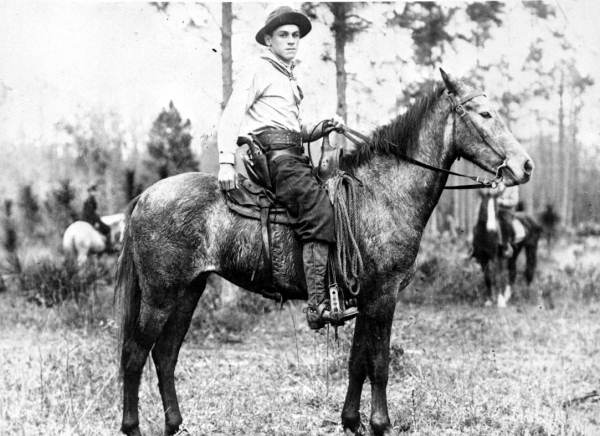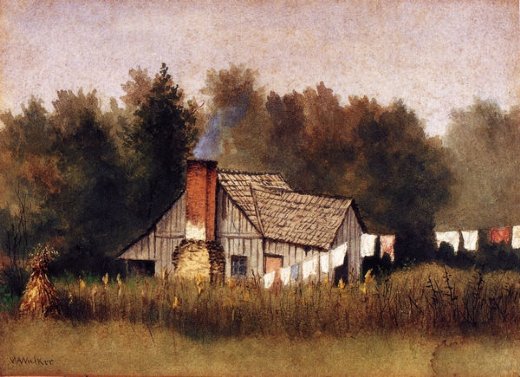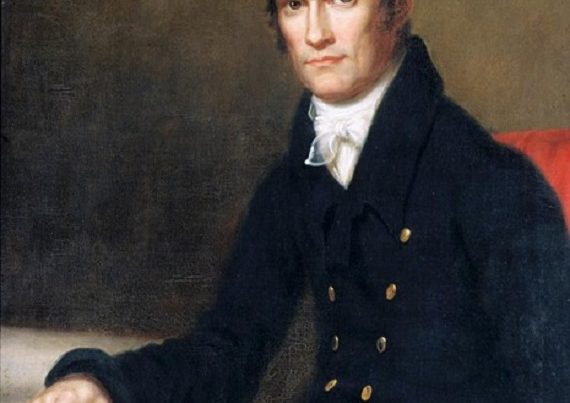Reading on the Abbeville site articles about the South and the West, I was reminded of my newspaper piece on Florida as the Wild Wild (South) East, which had a popular run. It was inspired by a Frederic Remington article describing his adventures in Florida with cowboys in the 1880s. Our county (Marion, named for Gen. Francis Marion) was as big as all Rhode Island. It was big cattle country when we first moved there in 1956. You’d see working cowboys in worn boots and stained stetsons on the square.
Remington’s article had been loaned to me by the postmaster of Oklawaha (p.o. was a mile from our house), Willie Willis, who had arrived in the era in 1912 when the cowboy culture was alive and well. “Why I saw them right out that door” (pointing to main entrance). “They would ride the most dreadful horses, absolutely ‘varmints’…” (not surprising since their ponies existed off wiregrass) “and they always carried their long whips over their left shoulders with the ends trailing on the ground.”
Mr. Willis was a lifelong student of Florida history, and had University of Florida people visiting occasionally. He told, wryly, of entertaining two profs and their wives and going on at length about his favourite subject. When he paused, one of the wives remarked, “Why, Sam, Mr. Willis is like a real professor.” “No,” insisted her spouse, “real professors shut up after 45 minutes.” So, as soon as Mr. Willis realized I was really interested, he shared items with me, including the already mentioned Remington article in Harpers magazine.
After all, who knew that Florida had once had a true cattle industry? It was started by the Spaniards who carefully carted longhorns from Spain to Florida, and then let them escape. The cattle thrived in Florida, but unlike their Texas kin who were often 6’ tall at the shoulder, the Florida variety were smaller (little nutrition in the grass). But they had horns just as big as those of their Western cousins. Actually, the Seminoles, before being driven into the Everglades, had become cattle “barons.” A number of things the Indians did remained a constant with the new settlers.
Right after publication of my cowboy stuff, Dad suffered a spell that put him in the hospital for several weeks. Mother and I visited every day, and when I realized Dad’s “roommate” looked very friendly, I introduced myself and, sure enough, the gentleman was not just a good talker—he had been one of those long ago cowboys, complete with whip!
He explained why the whip was used. Not to hit cattle. It was to drive them, mainly by cracking the whip, and the old timers were called “Florida Crackers.” “Hey, could you take the fly off a mule’s ear at 20 feet and not hit the ear?,” I inquired. (He had been telling me that making a whip was a sort of passage to manhood by the teens, who each constructed their own personal whip, never swapped or loaned.) “Yes,” he laughed, I have done that a few times.”
On and on he went (with my questions), telling of old times. For 40 years or so Florida provided the meat for Chicago and New York and other bastions of Northern civilization. There were round-ups and cattle drives—and, in between, the cowboys stole herds from each other. When pursued they would trade their ponies for swamp boats, because “a boat don’t leave no trail.”
The gentleman and I had a wonderful time “reminiscing,” and it was a shock to go to Dad’s room and see an empty bed. My friend had died the night before. The next day when we reached the room there was a well-bred lady in a handsome suit, boxing up the “leftovers.” As soon as we spoke to her, she remarked to me “Are you the Young Lady…” (remember, this was a long time ago!) “who used to talk to my father?” Hardly waiting for my reply, she added, “We–my whole family–want to thank you for talking to my father. He told me how much he had enjoyed talking about Old Times.” So he must have been one of those cowboy-to-cattle- barons that you read about.
You know, Florida’s cattle country ran in a straight line, in a hundred miles width that was just below Orlando. I remember going there before Disney rearranged everything. It was bucolic farm land that ended at Tampa, where the meat intended for the North was gathered for shipment.
Now before the Seminoles were chased into the swamps, they had a profitable cattle business themselves. And they depended on their “cattle dogs” which were all pure wolves. Those wolf-dogs were highly prized by the white cattlemen who (it was said) considered one such “dog” worth at least 3 cowboys. They paid huge prices to the Seminoles for trained wolves. It seems that the Indians kept a close look-out for Likely looking female wolves about to whelp, which they always did away from the pack. Thus the humans knew exactly where the whelping took place and at 2-3 days, they would see the “wolfess” leave to hunt her own dinner. While she was gone the Indians would take the likeliest pup and leave a large haunch of meat to pacify the mother, so she wouldn’t look for her puppy.
Then (and here comes the incredible part) a squaw would serve as a wet-nurse and so the pup grew up thinking he was a person—not a wolf! I don’t know how they trained them for cattle-duty, but the American cattlemen certainly appreciated their virtues. I might add, they were black wolves with very short hair. But, of course, Americans couldn’t stop shooting wolves, until none remained. The Seminoles tried with dog pups, but the dog mentality never came close to their wild cousins.








My Granny and Grandaddy got married in Ocala in 1940. Granny was born and raised in Citra a few miles north of Ocala, Grandaddy was from Gainesville. I enjoyed your essay, gives a picture of Ocala before being overrun with retirees. The company I work for has HQ in Ocala and it saddens me that Florida where my roos on my mom’s side go back to 1820s is a place where no one is from. ( Nor even me. Un from New Jersey but I have lived in Florida since I turned 20 in 1990 and attended the University of North Florida in Jacksonville )